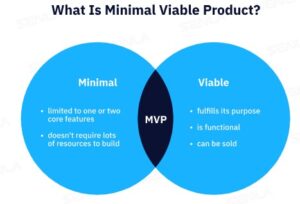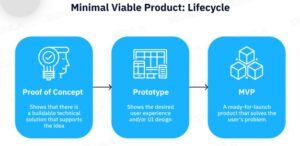In the fast-paced world of software development, turning a groundbreaking idea into a successful product involves careful planning and execution. Enter the MVP or Minimal Viable Product, a concept that has proven to be a game-changer for both startups and established enterprises. Let’s delve into what MVP is and explore the crucial steps in building one.
Understanding MVP
MVP Definition and Purpose
MVP, short for Minimal Viable Product, represents a strategic approach in software development. It revolves around releasing a product with the bare minimum features necessary to solve a specific user problem. The primary goal is to collect valuable user insights and feedback.
MVP in Action: 8 Steps to Building Success
-
Defining the Idea
- Identify the core problem your product aims to solve.
-
Conducting Market Research
- Explore the market landscape to ensure your idea is unique and viable.
-
Selecting Features for the Product
- Carefully choose the essential features required for your MVP.
-
Defining Limitations
- Evaluate time, budget, and regulatory constraints to set realistic expectations.
-
Choosing the Development Method
- Decide between no-code development, in-house development, or outsourcing.
-
Conducting the Discovery Phase
- Invest time in thoroughly understanding your product, market, and technical requirements.
-
Developing the Product
- Implement the chosen features with a focus on efficiency and user experience.
-
Gathering Feedback
- Release the MVP and actively seek user feedback to refine and improve.
What is MVP in Software Development?

MVP in Software Development
Differentiating MVP from Prototype and POC
Understanding MVP requires distinguishing it from related terms like prototype and proof of concept (POC).
-
Proof of Concept (POC):
- Demonstrates technical feasibility without creating a fully functional product.
-
Prototype:
- Displays the user interface and intended user flow but lacks full functionality.
-
MVP Lifecycle:
- Prototypes and POCs can be part of the early stages but are not mandatory.
The Purpose of MVP in Software Development
Unlocking Business Goals with MVP
The MVP serves multiple purposes crucial for successful software development.
-
Prove Commercial Viability:
- Test if your idea can turn a profit, essential for gaining investor confidence.
-
Conduct Customer and Product Research:
- Gather feedback to refine the product and understand market dynamics.
-
Minimize Risks:
- Test ideas with minimal investment, avoiding extensive development costs.
-
Fast Release:
- Gain a competitive edge by quickly introducing your product to the market.
-
Lead Generation:
- Build a user base and turn early adopters into brand advocates.
Stages of Building an MVP in Software Development

MVP Lifecycle
Guiding You Through the Process
Step 1: Envision the Idea for Your Product
- Identify a problem and envision a solution that adds value to users.
Step 2: Conduct Initial Market Research
- Ensure your idea is unique and assess potential market demand.
Step 3: Select Core Features
- Choose essential features, focusing on the MVP’s minimalistic nature.
Step 4: Consider Limitations
- Evaluate time, budget, and regulatory constraints to set realistic expectations.
Step 5: Choose the Development Method
- Decide between no-code development, in-house development, or outsourcing.
Step 6: Carry out the Discovery Phase
- Thoroughly understand your product, market, and technical requirements.
Step 7: Development
- Implement chosen features with a focus on efficiency and user experience.
Step 8: Launch and Gather Feedback
- Release the MVP, actively seeking user feedback for improvements.
Top Mistakes in MVP Software Development
Creating a Minimum Viable Product (MVP) is a common approach in software development to quickly launch a product with minimal features to gather feedback and validate ideas. However, there are common mistakes that teams often make during the MVP development process. Here are some top mistakes to avoid:
- Overloading Features: One of the main purposes of an MVP is to focus on essential features that address the core problem. Including too many features can lead to scope creep and defeat the purpose of creating a minimum viable product. Prioritize features based on their impact on the core functionality.
- Ignoring User Feedback: The whole point of an MVP is to gather user feedback and iterate on the product. Ignoring or undervaluing user feedback can result in a product that doesn’t meet user needs or expectations. Actively engage with users, analyze feedback, and incorporate it into future iterations.
- Incomplete Market Research: Failing to conduct thorough market research before building an MVP can lead to a product that doesn’t address the actual needs of the target audience. Understand your target market, their pain points, and the existing solutions in the market to create a product that stands out.
- Poorly Defined Goals: Without clear goals and objectives for the MVP, it’s challenging to measure its success. Define specific, measurable, and achievable goals for the MVP, such as user acquisition targets, conversion rates, or user engagement metrics.
- Neglecting Scalability: While an MVP is designed for quick launch and validation, it’s crucial to consider scalability early on. If the product gains traction, a lack of scalability can lead to performance issues and hinder user experience. Plan for scalability to accommodate future growth.
- Lack of Testing: Rushing through the testing phase or neglecting it altogether can result in a product with numerous bugs and usability issues. Thoroughly test the MVP to identify and fix any issues before releasing it to users. This includes functional, usability, and performance testing.
- Inadequate Documentation: Clear and comprehensive documentation is often overlooked in the rush to launch an MVP. Lack of documentation can hinder collaboration among team members and make it challenging for future development. Document the code, architecture, and any important decisions made during development.
- Failure to Plan for Iterations: An MVP is not a one-time release; it’s the starting point for continuous improvement. Failing to plan for future iterations based on user feedback can result in a stagnant product that fails to evolve with changing market needs.
- Misjudging Resources and Timeline: Underestimating the resources and time required to build the MVP can lead to rushed development, compromising the quality of the product. Conduct a realistic assessment of the required resources and set achievable timelines.
- Ignoring Design and User Experience: A poor user interface and user experience can drive users away, even if the core functionality is sound. Pay attention to design and usability to ensure that users have a positive and engaging experience with the MVP.
By avoiding these common mistakes, development teams can increase the chances of creating a successful MVP that effectively addresses user needs and sets the foundation for future product growth.
Conclusion
MVP is a powerful approach to software development, offering a strategic path to product success. By following the outlined steps and avoiding common mistakes, you can transform your innovative idea into a market-ready product. Whether you’re a startup or an established enterprise, embracing the MVP methodology can be the key to turning your vision into reality.